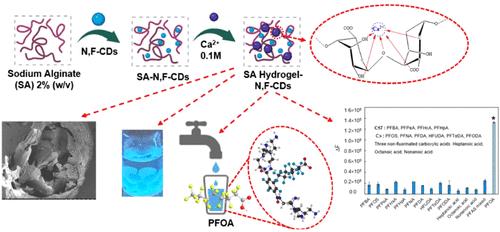用于检测饮用水中全氟辛酸的荧光海藻酸钠水凝胶-碳点传感器
IF 6.7
1区 化学
Q1 CHEMISTRY, ANALYTICAL
引用次数: 0
摘要
全氟烷基和多氟烷基物质,特别是全氟辛酸,由于其持久性、抗降解性和生物蓄积性,正在成为新的环境和健康问题。在这项研究中,我们建立了一个基于氮和氟化碳点(N,F-CDs)修饰的海藻酸钠(SA)水凝胶的敏感和选择性检测平台,以增强对天然和工程水系统中PFOA的检测。优化后的SA水凝胶- n, F-CD复合材料在480 nm处表现出较强的荧光,检测限低至0.001 ppt。利用扫描电子显微镜(SEM)、傅里叶变换红外光谱(FT-IR)、粉末x射线衍射(PXRD)、x射线光电子能谱(XPS)和zeta电位谱对该传感器进行了表征,揭示了其结构完整性、官能团以及SA水凝胶- n,F-CDs网络的表面电荷。灵敏度评估表明,对PFOA浓度在1至66 ppq范围内的线性荧光响应。选择性测试证实,该传感器能够将全氟辛烷酸与其他全氟化合物区分开来,而其他物质的干扰最小。通过不同地点自来水样品的加标回收率实验,验证了该传感器的实用性,回收率在94% ~ 106.6%之间。该传感器为PFAS的检测提供了一个可靠、高效、高灵敏度的平台,展示了其在现实世界中PFAS监测应用的潜力。本文章由计算机程序翻译,如有差异,请以英文原文为准。

Fluorescent Sodium Alginate Hydrogel–Carbon Dots Sensor for Detecting Perfluorooctanoic Acid in Potable Water
Per- and polyfluoroalkyl substances (PFASs), especially perfluorooctanoic acid (PFOA), are emerging environmental and health concerns due to their persistence, resistance to degradation, and bioaccumulation. In this study, we developed a sensitive and selective detection platform based on a sodium alginate (SA) hydrogel modified with nitrogen and fluorinated carbon dots (N,F-CDs) to enhance the detection of PFOA in natural and engineered water systems. The SA hydrogel–N,F-CD composite exhibited strong fluorescence at 480 nm after optimization, achieving a detection limit as low as 0.001 ppt. The sensor was characterized by using Scanning Electron Microscopy (SEM), Fourier-Transform Infrared Spectroscopy (FT-IR), Powder X-ray Diffraction (PXRD), X-ray Photoelectron Spectroscopy (XPS), and zeta potential spectroscopy, revealing its structural integrity, functional groups, and the surface charge of the SA hydrogel–N,F-CDs network. Sensitivity assessments demonstrated a linear fluorescence response to PFOA concentrations ranging from 1 to 66 ppq. Selectivity tests confirmed the sensor’s ability to distinguish PFOA from other perfluorinated compounds, with minimal interference from other substances. The practical applicability of the sensor was validated using spiked recovery experiments with tap water samples from various locations, achieving recovery rates between 94% and 106.6%. This sensor offers a reliable, efficient, and highly sensitive platform for the detection of PFAS, demonstrating its potential for real-world PFAS-monitoring applications.
求助全文
通过发布文献求助,成功后即可免费获取论文全文。
去求助
来源期刊

Analytical Chemistry
化学-分析化学
CiteScore
12.10
自引率
12.20%
发文量
1949
审稿时长
1.4 months
期刊介绍:
Analytical Chemistry, a peer-reviewed research journal, focuses on disseminating new and original knowledge across all branches of analytical chemistry. Fundamental articles may explore general principles of chemical measurement science and need not directly address existing or potential analytical methodology. They can be entirely theoretical or report experimental results. Contributions may cover various phases of analytical operations, including sampling, bioanalysis, electrochemistry, mass spectrometry, microscale and nanoscale systems, environmental analysis, separations, spectroscopy, chemical reactions and selectivity, instrumentation, imaging, surface analysis, and data processing. Papers discussing known analytical methods should present a significant, original application of the method, a notable improvement, or results on an important analyte.
 求助内容:
求助内容: 应助结果提醒方式:
应助结果提醒方式:


